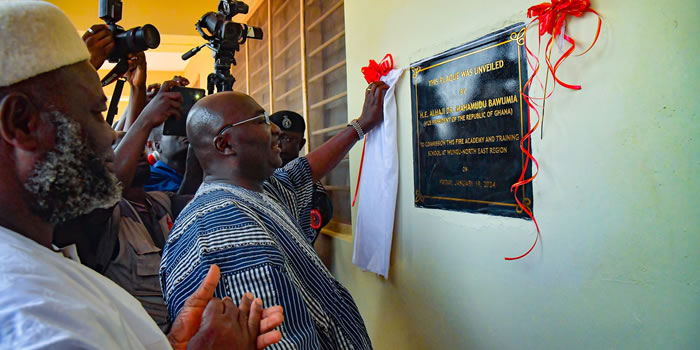

Production And Gainful Employment
The economic base of the West Mamprusi District is agriculture with an average 80% of the economically active population engaged in one form or other of it. Agricultural activities in the district include crop production, livestock and fisheries. Only 54.7% of the 80% however farm as a major activity. Agriculture is basically on a subsistence level with smallholder farmers representing the main users of agricultural land. The average farm sizes vary from 0.5 ha to 2.4 ha.
The predominant type of farm labour is from the immediate family (man, wife or wives and children) a factor that may account for the love of large families as was explained under the population profile of the district. There are however periods where farm labour is hired to supplement family labour. Because children in the family, especially those above 15 years are intensively used, there is an unacceptably low enrolment of children in primary and junior secondary school as captured under the current status of education in the district.
The major crops farmed in the district are sorghum, groundnut, millet, beans, maize and rice. Cash crops in this district are rice, cotton, tobacco, vegetables and cashew. Crop production in the district is on a subsistence basis whereby small farm holder farmers produce for family upkeep and occasional sale. There are however, a number of commercial farmers.
The major crops grown in the district are maize, millet, rice groundnuts, beans, sorghum, Bambara beans and yams. These crops are grown during the rainy season. The total acreages cultivated and average yields for these crops are indicated in the table 2 on page 19. Dry season farming is done along the banks of the White Volta. Crops cultivated include leafy vegetables, tomatoes, onions, soybeans, pepper and tobacco.
The potential of dry season farming is limited by inadequate water-retaining structures including dams and dugouts. Major cash crops grown in the district are groundnuts, rice tobacco and cotton. Vegetables grown include pepper, tomatoes and onions and this is done along the banks of the White Volta.
There are large tracts of fertile land in the Yizesi; Kunkua, Katigri and Soo valleys, which could be utilized for large-scale, rice production. The soil conditions in this area are rich and loamy and have a very high water holding capacity. These conditions are very conducive for commercial rice production.
TOTAL CROP ACREAGES AND OUTPUT | ||
Crop | Area (Hectares Cultivated | Output (metric Tonnes |
Maize | 9,326 | 9,028 |
Millet | 10,450 | 10,400 |
Rice | 1,208 | 2,679 |
Sorghum | 16,379 | 18,664 |
Groundnuts | 10,350 | 12,000 |
Beans | 9,160 | 9,770 |
Yams | 151 | 1,010 |
Source: West Mamprusi District Assembly
The main tree crops indicated in field discussions are Sheanut and Dawadawa (both harvested from the wild) and small plantings of cashew. To promote the production of cashew, the District Assembly has established a 10-hectare cashew plantation on the outskirts of Walewale.
Land Tenure and Development
Land in Walewale is owned by individual families whose control rest in the family head as the sole custodian. These lands belong to the Mamprugu skin and the divisional chief of the town acts as the resident trustee on behalf of the ‘Nayiri’. Title to lands is derived from the allodia superior title.
Lesser interests are derived from this and one unique thing about this tenurial arrangement is that, ownership becomes perpetual after acquisition for housing purposes. Though still under the legal ownership of the skin, once the proper procedure of land acquisition for housing development is complete, the interest on land perpetuates.
This however, does not apply to agricultural lands. Here, no agricultural lands are sold, hired or leased for, at least, peasant farming. All that is required is to approach the landowner with “kola money” and a plot is offered. This system of ownership of land in the study area is friendly to all kinds of land development - either for residential purpose or otherwise.
This will be sanctioned subject, however, to the fact that it conforms to the environmental requirements of the area by the judgment of the people, which is very paramount. The procedure of land acquisition in Walewale will be examined in the next chapter. Despite the relaxed system of landownership, no stranger wishing to acquire land for any purpose in an area and Walewale for that matter, should under-rate the possible dangers.
He should endeavour to contact the chief or a leading figurehead of the place for guidance. A lapse in this direction could jeopardize the intended development. Though the tenurial arrangement is conducive for any large-scale land development, it will do one a lot of good to investigate the title to land. Mixed farming is practiced in the district as a means of farm insurance against risks. Crops cultivated under this system include maize, millet, sorghum and groundnuts. Rice is solely cropped. (Table 21)
CURRENT & RECOMMENDED FARMING PRACTICES | ||||
| Farming Method | Output/Acre | ||
Crop | Current Practice | Recommended practice | Current | Expected |
Maize | Mixed Cropping | Sole Cropping | 3-4bags | 7bags |
Rice | Sole Cropping | Sole Cropping | 4-6bags | 12 bags |
Millet | Mixed Cropping | Sole Cropping | 2 bags | 5bags |
Sorghum | Mixed Cropping | Sole Cropping | 2-3bags | 5 bags |
Groundnu | Mixed Cropping | Sole Cropping | 4 bags |
|
Source: West Mamprusi District Assembly
Observations from the field survey indicate that the method of farming is basically traditional using hoes and cutlasses. Food production in some cases is mechanized with the use of animal traction and few tractors. The yield from the land under cultivation (ref Table 21) shows that in almost all cases except for groundnuts, the yield is half of that expected.
Primary Processing
Primary Processing of agriculture is done in the district though not on a large scale. Mostly it simply involves transforming farm produce into another form for local consumption. Sheanut processing for exports is however picking up in the district. Some of the processed produce is groundnut oil, parboiled rice, Shea butter, smoked fish and Dawadawa spice.
Storage Facilities
The local barn constitutes the most common storage facility in the district. The barns are constructed with grass-thatched roofs supported with wooden structures. The survey analysis shows the barn as the most commonly used storage method with 78% of respondents using this method. Refer to Table 22 below for details. Eight percent (8%) indicated that they benefited from roofed storage facilities. This was particularly the case with Janga where an NGO, Northern Empowerment Association (NEA) stored the maize produced by farmers.
STORAGE FACILITIES | ||
Type | No. of Respondents | Percentage |
Traditional Barn |
| 78 |
Roofed Storage |
| 8 |
Storage in the Yard | 71 | 3 |
Roofed storage in the field | 7 | 2 |
In the field | 3 | 3 |
No storage | 5 | 6 |
Total | 91 | 100 |
Another practice gaining currency in the district is the use of jute bags for storing maize, rice, guinea corn, millet, groundnuts and beans. These produce are bagged after they have been thoroughly dried.
Survey results indicate that the use of pesticides and insecticides for storage of produce is not very popular among most farmers in the district. 62% of respondent did not apply any chemicals to their stored produce 46% of those who applied chemicals indicated the use of chemicals such as karate, acthelic and Gaamtox. Eight percent (8%) indicated the use of traditional sources such as neem seeds and ordinary ash.
A marketing analysis carried out revealed that about 56% of processed products were marketed within the settlements where production occurred. The district has seven (7) markets, the largest being the Walewale market followed by the Bulbia market.
Livestock Farming
The flat grassland vegetation of the area facilitates the rearing of livestock and poultry in the district. Animals reared include cattle, sheep, goats, pigs, local birds and domesticated guinea fowl. The cattle population mainly consists of the small West African shorthorn breed and the rest being the Zebu type with few Sennas and N’damas. The sheep and goats are mainly the West African Dwarf breeds. The Directorate of Agriculture has begun the promotion of new breeds of guinea fowls. The Wulugu Livestock Company has started ostrich farming.
Field information revealed that about 60% of adults own at least one cow, 80% own at least a goat or sheep and 90-100% own fowls. All livestock are maintained on free range with isolated cases of supplementary feeding in the form of household waste or spoiled grain. The people in the district see the breeding of livestock as a viable investment. In addition, livestock is kept for religious reasons or as a source of animal protein.
The common disease affecting livestock in the district includes tick, worm infections, diarhhoea, black leg, foot and mouth disease, pneumonia, ascariasis, anthrax and helminthiasis.
Dams
There are only eight dams and dugouts in the West Mamprusi District located at Gbimsi, Diani, Nayorku, Gbani, Nabari, Wulugu, Nasia and Wungu. Most of these as seen in the table below are in a very bad state and requires rehabilitation.
Dams and Dugouts in the District | ||
LOCATION | DESCRIPTION (Dam/Dugout | CONDITION |
Gbimsi | Dam | Silted Up and requires rehab. |
Diani | Dam | Silted Up and requires rehab. |
Nayorku | Dam | Silted Up and Wall damaged requires serious rehab |
Gbani | Dam | Silted Up and requires rehab |
Nabari | Dugout | Silted Up and requires rehab |
Wulugu | Dugout | Silted Up and requires rehab |
Nasia | Dam | In good condition |
Wungu | Dugout | Silted Up and requires dredging |
The scanty and poor state of the few water bodies in the district does not provide any incentive for dry season farming and in view of the fact that the area is a major cattle raising area, there are serious economic consequences requiring swift and urgent action to save the situation.
Problems of Agricultural Production
- Unreliable rainfall in terms of duration, timing and amount
- Declining soil fertility especially in the eastern portion of the district.
- High cost of inputs and spares.
- Continuous use of old implements for farming.
- Perennial bush fires.
- In adequate supply of agricultural machinery and equipment
- Insufficient market structure.
- Unstable prices for agricultural produce.
- Poor road infrastructure, e.g., poor road network.
- Weak institutional support for farmers, e.g. credit
- Lack of small irrigational dams to ensure all year farming.
- High post harvest losses.
- High rural – urban labour exodus.
- Poor agricultural programme coverage and inadequate extension services limiting the dissemination of information relating to productivity increase.
Measures to Address situation
The economic development of the district is largely dependent on agriculture. There should therefore be serious and sustained moves to promote agricultural development in the district. Means of improving the situation include the following.
1. Investment is needed in adequate land preparation to add value to the abundant land in the district for increased agricultural production. This should include:
2. Judicious and strategic land clearing for crop production;
3. Contour binding
4. Efficient management of the drainage system;
5. Planning of infiltration bands of grass;
6. Settlement erosion control;
7. Composting and its application;
8. Use of farmyard manure;
9. Green maturing and short fallows using cover crops;
10. Construction of stoniness on steeper slopes; and
11. Integration of livestock into the farming system, by making use of crop residues for feed, to help reduce pressure on grazing resources and vegetative cover.
12. The introduction of a block farming system will increase the acquisition and utilization of a large size of farmland by private small-scale farmers from nearby villages for the production of specific crops. This system will allow the maintenance of privately owned and managed small framings while permitting the farmer to benefit from cost-effective mechanized another allied services associated with large scale scientific farming.
Extensive research activity leading to the identification of seed varieties suitable for the ecological and agro-climatic conditions. Provision of agricultural machinery and equipment such as animal bullocks, tractors, combine harvesters, spraying machines another inputs such as fertilizers and agro-chemicals. Animal traction is an environmentally friendly technique, which economizes on land. The district should seriously promote this system through bullocks, and donkeys for land preparation and transport. Other allies services include; adoption of existing manufacturers (local blacksmiths etc) in promoting animal traction;
- Provision of after-sale services;
- Upgrading skills of local artisans; and
- Rearing and dressing of donkeys and bullocks;
Encourage farmers to apply farmyard manure and undertake compost making and inorganic fertilizer. Adoption and implementation of forestation activities including the following;
- Establishment of community tree nurseries;
- Planting of woodlots; and
- Cultivation of plantations (cashews, mango etc)
Implementation of bush fire control activities Enactment
Date Created : 11/27/2017 3:55:27 AM











 facebook
facebook
 twitter
twitter
 Youtube
Youtube
 +233 593 831 280
+233 593 831 280 0800 430 430
0800 430 430 GPS: GE-231-4383
GPS: GE-231-4383 info@ghanadistricts.com
info@ghanadistricts.com Box GP1044, Accra, Ghana
Box GP1044, Accra, Ghana